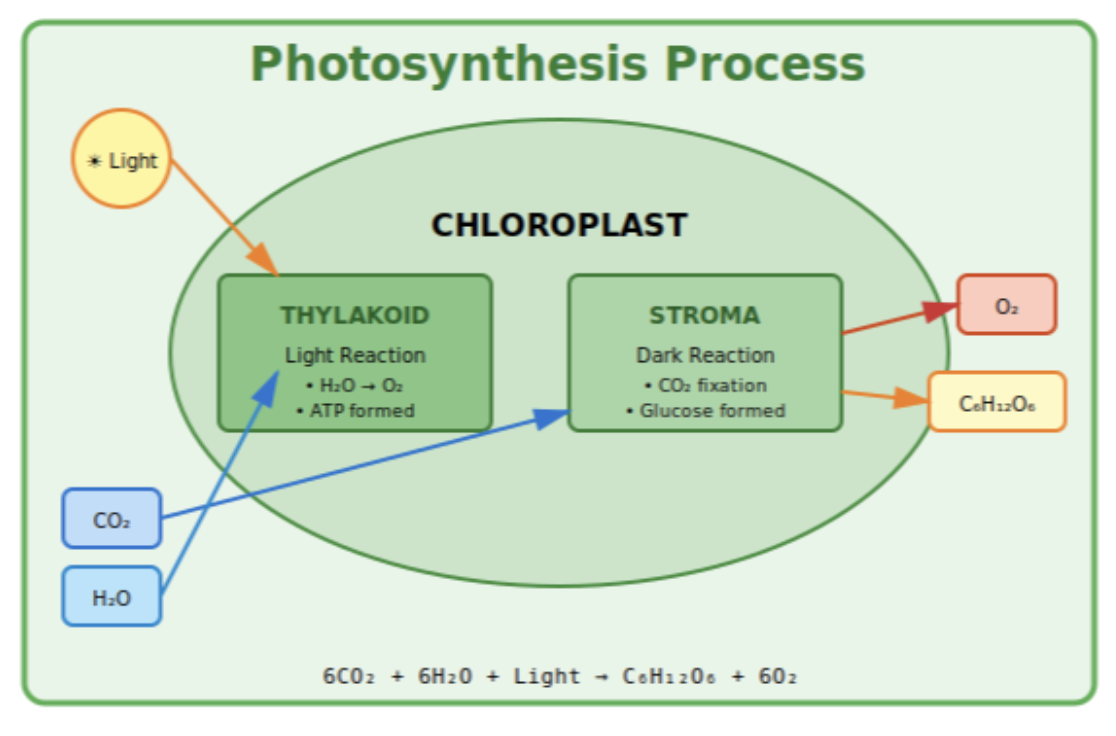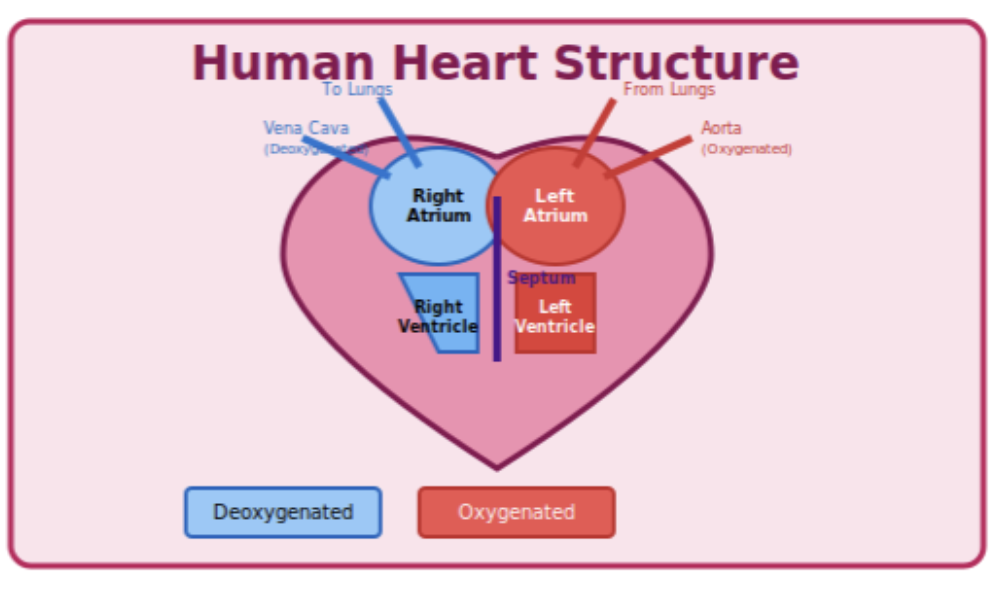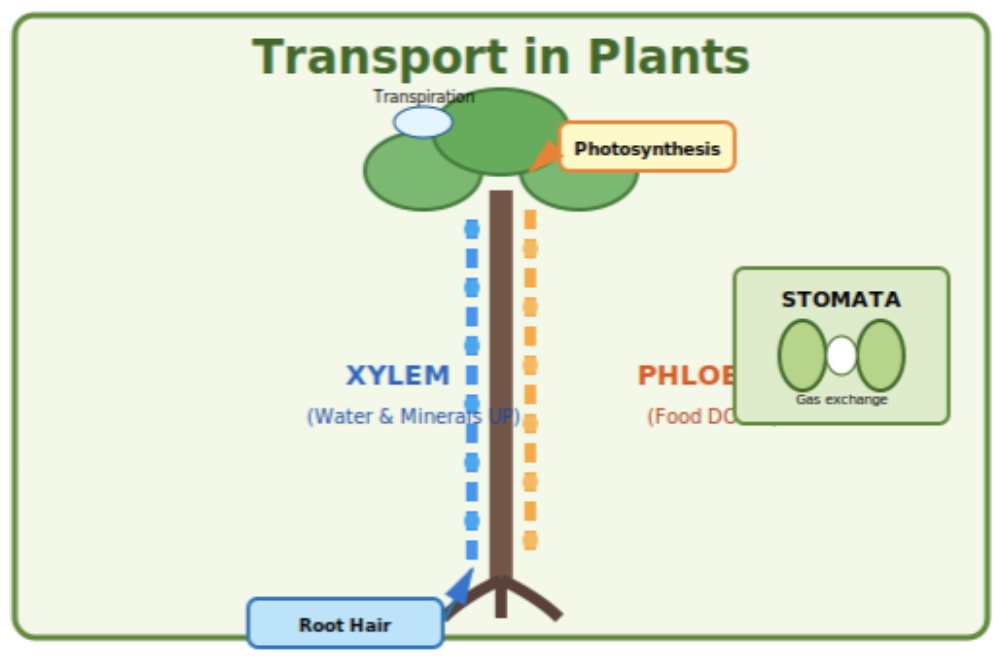










Courses

By Shailendra Singh
|
Updated on 3 Nov 2025, 14:58 IST
Life processes are the fundamental activities performed by living organisms to maintain life. Understanding these processes is crucial for Class 10 students preparing for CBSE board examinations. This comprehensive guide covers nutrition, respiration, transportation, and excretion the four major life processes that sustain all living beings.
According to the NCERT curriculum, mastering this chapter requires not only theoretical understanding but also the ability to draw and label diagrams accurately, solve previous year questions, and apply concepts through MCQs and exercises. This guide provides everything from concise notes to mind maps, ensuring complete preparation.
1. Definition and Characteristics of Life Processes
2. Nutrition
3. Photosynthesis Equation (Must Remember)
6CO₂ + 12H₂O --Light/Chlorophyll--> C₆H₁₂O₆ + 6O₂ + 6H₂O
Loading PDF...
4. Human Digestive System Components
5. Respiration

6. Human Respiratory System

JEE

NEET

Foundation JEE

Foundation NEET

CBSE

7. Transportation in Humans
8. Human Excretory System

9. Transportation in Plants

Diagrams carry significant marks in board examinations. Practice these labeled diagrams regularly:
| Diagram | Key Labels to Include | Marks Weightage |
| 1. Human Digestive System | Mouth, esophagus, stomach, liver, pancreas, small intestine, large intestine, anus | 3-5 marks |
| 2. Leaf Cross-Section | Upper epidermis, palisade mesophyll, spongy mesophyll, lower epidermis, stomata, guard cells, vascular bundle (xylem, phloem) | 3 marks |
| 3. Stomata with Guard Cells | Guard cells, stomatal pore, chloroplasts, nucleus | 2-3 marks |
| 4. Human Respiratory System | Nostrils, pharynx, larynx, trachea, bronchi, bronchioles, alveoli, diaphragm | 3-5 marks |
| 5. Structure of Nephron | Bowman's capsule, glomerulus, proximal convoluted tubule, Loop of Henle, distal convoluted tubule, collecting duct | 3-5 marks |
| 6. Human Heart (Sectional View) | Right atrium, right ventricle, left atrium, left ventricle, septum, valves, aorta, vena cava, pulmonary artery, pulmonary vein | 5 marks |
| 7. Structure of Alveolus | Alveolar sac, blood capillaries, thin wall for gas exchange | 2-3 marks |
| 8. Amoeba Nutrition | Pseudopodia, food vacuole, ingestion, digestion, egestion | 2-3 marks |
| 9. Structure of Chloroplast | Outer membrane, inner membrane, grana, stroma, thylakoids | 2 marks |
| 10. Pathway of Blood in Heart | Double circulation diagram showing pulmonary and systemic circulation | 3 marks |
Materials Needed: Pencil, ruler, eraser, colored pencils (optional)
Step 1: Draw the Basic Outline
Step 2: Add Accessory Organs
Step 3: Label in Proper Sequence (Top to Bottom)
Step 4: Add Functional Annotations
Common Mistakes to Avoid:
Quick Drawing Technique (Takes 3 minutes)
Step 1: Draw the Outline
Step 2: Draw Layers from Top to Bottom
Step 3: Add Vascular Bundle
Step 4: Add Stomata Detail
Step 5: Label Clearly
Pro Tips:
Simple 5-Step Method:
Step 1: Draw two parallel curved lines (like parentheses) facing each other: ( )
Step 2: Make them kidney-shaped by adding a curve at each end
Step 3: Add a small oval (nucleus) in each guard cell
Step 4: Draw 5-6 small circles (chloroplasts) in each guard cell
Step 5: Label:
Open vs Closed Stomata:
Memory Trick: Guard cells look like kidneys (kidney-shaped) and they guard the opening!
Practice Set 1: Basic Diagrams
Practice Set 2: Advanced Diagrams 4. Draw the human respiratory system and show the mechanism of breathing 5. Draw and explain how oxygen and CO₂ are exchanged in alveoli
Practice Set 3: CBSE Pattern Questions (Previous Years)
| Year | Question | Marks |
| 2023 | Draw a labeled diagram of human respiratory system and explain the mechanism of breathing | 5 |
| 2022 | Draw alveolus and show the exchange of gases | 3 |
| 2020 | List the pathway of air during inhalation. Draw and label alveolus | 3 |
| 2019 | Draw human respiratory system. How does exchange of gases occur in alveoli? | 5 |
Step-by-Step Drawing Guide:
For Complete Respiratory System:
For Alveolus (Gas Exchange):
What are Life Processes?
Essential activities performed by organisms to sustain life: Nutrition, Respiration, Transportation, Excretion, Control & Coordination, Growth, Reproduction.
| Type | Definition | Example |
| Autotrophic | Self-food preparation | Plants (Photosynthesis) |
| Heterotrophic | Depends on others | Animals, Fungi, Bacteria |
Photosynthesis: 6CO₂ + 12H₂O → C₆H₁₂O₆ + 6O₂ + 6H₂O (in chloroplasts, needs light & chlorophyll)
Human Nutrition:
| Type | Location | Equation | ATP Yield |
| Aerobic | Mitochondria (with O₂) | Glucose + O₂ → CO₂ + H₂O | 38 ATP |
| Anaerobic | Cytoplasm (no O₂) | Glucose → Lactic acid/Ethanol + CO₂ | 2 ATP |
Human Respiratory System:
Pathway: Nostrils → Trachea → Bronchi → Bronchioles → Alveoli (gas exchange)
In Humans:
In Plants:
Human Excretory System:
Plant Excretion:
| Process | Key Equation/Fact |
| Photosynthesis | 6CO₂ + 12H₂O → C₆H₁₂O₆ + 6O₂ + 6H₂O |
| Aerobic Respiration | C₆H₁₂O₆ + 6O₂ → 6CO₂ + 6H₂O + 38 ATP |
| Anaerobic (Muscles) | Glucose → Lactic acid + 2 ATP |
| Anaerobic (Yeast) | Glucose → Ethanol + CO₂ + 2 ATP |
Dental Formula (Human):
Milk teeth: (2/2, 1/1, 0/0, 2/2) × 2 = 20
Permanent: (2/2, 1/1, 2/2, 3/3) × 2 = 32
Blood Pressure: 120/80 mm Hg (Systolic/Diastolic)
| Basis of Difference | Aerobic Respiration | Anaerobic Respiration |
| 1. Oxygen Requirement | Requires oxygen | Does not require oxygen |
| 2. Location in Cell | Mitochondria (Krebs cycle) and Cytoplasm (Glycolysis) | Only in Cytoplasm |
| 3. Complete Equation | C₆H₁₂O₆ + 6O₂ → 6CO₂ + 6H₂O + Energy | Glucose → Lactic acid (muscles) OR Ethanol + CO₂ (yeast) + Energy |
| 4. ATP Production | 38 ATP molecules per glucose | 2 ATP molecules per glucose |
| 5. End Products | Carbon dioxide (CO₂) and Water (H₂O) | Lactic acid (in muscles) OR Ethanol + CO₂ (in yeast/plants) |
| 6. Energy Release | High (686 kcal per glucose molecule) | Low (only about 50 kcal) |
| 7. Complete/Incomplete | Complete oxidation of glucose | Incomplete oxidation of glucose |
| 8. Examples in Nature | Most plants, animals, humans (normal conditions) | Yeast (fermentation), human muscles (during vigorous exercise), some bacteria |
| 9. Duration | Continuous process when O₂ available | Temporary process during O₂ shortage |
| 10. By-products | Non-toxic (CO₂ exhaled, H₂O used) | Can be toxic (lactic acid causes muscle cramps) |
| 11. Process Steps | Glycolysis → Krebs Cycle → Electron Transport Chain | Only Glycolysis → Fermentation |
| 12. Efficiency | Very efficient (~40% energy captured) | Less efficient (~2% energy captured) |
| Feature | Arteries | Veins |
| Function | Carry blood away from heart | Carry blood to heart |
| Blood Type | Oxygenated (except pulmonary artery) | Deoxygenated (except pulmonary vein) |
| Wall Thickness | Thick, elastic walls | Thin walls |
| Pressure | High blood pressure | Low blood pressure |
| Valves | Absent | Present (prevent backflow) |
| Blood Flow | Rapid, in spurts | Slow, steady |
| Position | Deep-seated | Superficial |
| Feature | Xylem | Phloem |
| Function | Transport water & minerals | Transport food (sugars) |
| Direction | Unidirectional (upward only) | Bidirectional (up and down) |
| Components | Tracheids, vessels, xylem parenchyma, xylem fibers | Sieve tubes, companion cells, phloem parenchyma, phloem fibers |
| Living/Dead | Dead cells (except parenchyma) | Living cells |
| Mechanism | Transpiration pull, root pressure | Translocation (requires energy - ATP) |
| Feature | Autotrophic | Heterotrophic |
| Definition | Organisms make their own food | Organisms depend on others for food |
| Energy Source | Sunlight (photosynthesis) or Chemicals (chemosynthesis) | Ready-made organic compounds |
| Examples | Green plants, some bacteria | Animals, fungi, most bacteria |
| Carbon Source | CO₂ from atmosphere | Organic compounds from other organisms |
| Types | Photoautotrophs, Chemoautotrophs | Holozoic, Saprotrophic, Parasitic |
Q1. Name the process by which Amoeba obtains its food. (2024)
Answer: Holozoic nutrition (Phagocytosis)
Q2. What is the role of HCl in our stomach? (2023)
Answer: (i) Provides acidic medium for pepsin activation (ii) Kills germs in food
Q3. Name the respiratory pigment in human beings. (2023)
Answer: Haemoglobin
Q4. What is the function of nephron? (2022)
Answer: Filtration of blood and formation of urine
Q5. Name the blood vessel that brings oxygenated blood to human heart. (2022)
Answer: Pulmonary vein
Q6. Where is bile produced? What is its function? (2020)
Answer: Produced in Liver. Function: Emulsification of fats (breaks large fat globules into smaller droplets)
Q7. What is the significance of emulsification of fats? (2019)
Answer: Increases surface area of fats for enzyme lipase action
Q8. Name the enzyme present in saliva. (2024)
Answer: Salivary amylase (Ptyalin)
Q9. What are the methods used by plants to get rid of excretory products? (2023)
Answer:
(i) Gaseous wastes (O₂, CO₂) diffuse through stomata
(ii) Excess water removed by transpiration
(iii) Waste products stored in leaves, bark, later shed
(iv) Some waste stored in cell vacuoles
Q10. Differentiate between arteries and veins. (2023)
Answer:
| Arteries | Veins |
| Carry blood away from heart | Carry blood to heart |
| Thick elastic walls | Thin walls |
| No valves | Valves present |
| Blood flow under high pressure | Blood flow under low pressure |
Q11. Why is small intestine longer in herbivores than carnivores? (2022)
Answer: Herbivores eat plant-based food rich in cellulose which takes longer time to digest. Hence, longer small intestine provides more time for complete digestion and absorption.
Q12. What is the role of epidermis in plants? (2020)
Answer:
(i) Protective layer against water loss
(ii) Guards against mechanical injury
(iii) Contains stomata for gaseous exchange
Q13. Describe the mechanism of urine formation in human kidneys. (2024)
Answer:
Three steps:
(i) Glomerular Filtration: Blood filtered in Bowman's capsule, filtrate contains water, glucose, amino acids, urea, salts
(ii) Selective Reabsorption: Useful substances (glucose, amino acids, water, salts) reabsorbed in tubular part
(iii) Tubular Secretion: Extra ions, water, unwanted substances secreted into tubule to form urine
Q14. Explain the process of breathing in human beings. (2023)
Answer:
Inhalation: Diaphragm contracts and moves down, ribs move up and outward → chest cavity volume increases → air pressure decreases → air rushes into lungs
Exhalation: Diaphragm relaxes and moves up, ribs move down and inward → chest cavity volume decreases → air pressure increases → air pushed out of lungs
Q15. What is double circulation? Describe its pathway. (2022)
Answer:
Double circulation: Blood passes through heart twice in one complete cycle
Pathway:
(i) Pulmonary Circulation: Right ventricle → Pulmonary artery → Lungs (oxygenation) → Pulmonary vein → Left atrium
(ii) Systemic Circulation: Left ventricle → Aorta → Body organs → Vena cava → Right atrium
Advantage: Efficient oxygen supply, separation of oxygenated and deoxygenated blood
Q17. (a) What is photosynthesis? Write the balanced chemical equation.
(b) Describe the role of following in photosynthesis: (i) Chlorophyll (ii) Sunlight (2024)
Answer:
(a) Photosynthesis is the process by which green plants prepare food (glucose) from CO₂ and H₂O in presence of sunlight and chlorophyll.
Equation: 6CO₂ + 12H₂O --Light/Chlorophyll--> C₆H₁₂O₆ + 6O₂ + 6H₂O
(b) (i) Chlorophyll: Absorbs light energy and converts it into chemical energy; acts as photoreceptor molecule; present in chloroplasts
(ii) Sunlight: Provides energy for splitting water molecules (photolysis); excites chlorophyll molecules; essential for converting light energy to chemical energy (ATP and NADPH formation)
Q18. (a) Draw a well labeled diagram of nephron.
(b) Explain how urine is produced in nephron. (2023)
Answer:
(a) [Draw nephron with labels: Bowman's capsule, Glomerulus, Proximal convoluted tubule, Loop of Henle, Distal convoluted tubule, Collecting duct]
(b) Explained in Q13 above (3 steps: Filtration, Reabsorption, Secretion)
Q19. (a) Distinguish between aerobic and anaerobic respiration.
(b) In which type of respiration is more energy released? Why? (2022)
Answer:
(a) See differences table above
(b)Aerobic respiration releases more energy (38 ATP vs 2 ATP) because:
Question 1 (5 marks) - CBSE 2024 Pattern
Draw a well-labeled diagram of human heart showing all four chambers. Show the direction of blood flow with arrows. Which chamber has the thickest muscular wall and why?
Expected Answer Points:
Question 2 (3 marks) - CBSE 2023 Pattern
Draw a diagram of stomata in open condition. Label: Guard cells, Stomatal pore, Chloroplasts. Why do guard cells have chloroplasts while other epidermal cells don't?
Expected Answer:
Question 3 (5 marks) - CBSE 2022 Pattern
Draw a labeled diagram showing nutrition in Amoeba. Explain the process briefly.
Expected Components:
Question 4 (3 marks) - CBSE 2020 Pattern
Draw a labeled sectional view of human heart and show the path of deoxygenated blood.
Expected Answer:
Question 5 (5 marks) - CBSE 2019 Pattern
(a) Draw a labeled diagram of respiratory system in humans.
(b) Explain the mechanism of gaseous exchange in alveoli.
Expected Answer: (a) Complete respiratory system diagram with all labels (as described earlier)
(b) Gaseous exchange mechanism:
| Formula Name | Chemical/Mathematical Representation | Explanation |
| Photosynthesis | 6CO₂ + 12H₂O → C₆H₁₂O₆ + 6O₂ + 6H₂O | Six molecules of carbon dioxide and twelve molecules of water, in presence of light and chlorophyll, produce one molecule of glucose, six molecules of oxygen, and six molecules of water |
| Aerobic Respiration | C₆H₁₂O₆ + 6O₂ → 6CO₂ + 6H₂O + 38 ATP | One glucose molecule, in presence of oxygen, completely oxidizes to produce six molecules each of carbon dioxide and water, releasing 38 ATP |
| Anaerobic Respiration (Muscles) | C₆H₁₂O₆ → 2C₃H₆O₃ + Energy (2 ATP) | Glucose breaks down into lactic acid (lactate) in absence of oxygen, releasing only 2 ATP |
| Anaerobic Respiration (Yeast) | C₆H₁₂O₆ → 2C₂H₅OH + 2CO₂ + Energy (2 ATP) | Glucose ferments into ethanol and carbon dioxide in absence of oxygen, releasing 2 ATP |
| Glycolysis | Glucose (6C) → 2 Pyruvate (3C each) + 2 ATP | First step of respiration; glucose split into two pyruvate molecules in cytoplasm, producing net 2 ATP |
| Blood Pressure (Normal) | 120/80 mm Hg | Systolic pressure (ventricular contraction) is 120 mm Hg; Diastolic pressure (ventricular relaxation) is 80 mm Hg |
| Dental Formula (Human Adult) | 2123/2123 × 2 = 32 | On each half jaw: 2 incisors, 1 canine, 2 premolars, 3 molars; both jaws × 2 = 32 teeth |
| Cardiac Output | CO = SV × HR | Cardiac Output = Stroke Volume (blood pumped per beat) × Heart Rate (beats per minute) |
| Energy from Glucose Oxidation | 1 mole glucose = 686 kcal | Complete aerobic oxidation of one mole (180g) of glucose releases 686 kilocalories or 2870 kJ of energy |
Central Concept: LIFE PROCESSES
Branch 1: NUTRITION
Branch 2: RESPIRATION
Branch 3: TRANSPORTATION
Branch 4: EXCRETION
Set 1: Nutrition (10 Questions)
Answers: 1(d), 2(a), 3(b), 4(b), 5(b)
Set 2: Respiration (10 Questions)
Answers: 6(d), 7(a), 8(b), 9(c), 10(b)
Set 3: Transportation (10 Questions)
Answers: 11(a), 12(c), 13(a), 14(a), 15(a)
Set 4: Excretion (10 Questions)
Answers: 16(b), 17(c), 18(b), 19(d), 20(a)
1. Time Management Strategy
2. Diagram Drawing Tips
3. Common Mistakes to Avoid
4. Topics for Full Marks
5. Blueprint-Based Weightage
| Topic | Expected Marks | Question Types |
| Nutrition | 6-8 marks | MCQ (1) + SA (2-3) + LA (3-5) + Diagram (3) |
| Respiration | 4-6 marks | MCQ (1) + SA (2-3) + Diagram (2-3) |
| Transportation | 5-7 marks | SA (2-3) + LA (3-5) + Diagram (3) |
| Excretion | 4-5 marks | MCQ (1) + SA (2-3) + Diagram (2-3) |
No courses found
Minimum 10-12 days for thorough preparation. Daily 1.5-2 hours: Theory (1 hour) + Diagram practice (30 min) + MCQ solving (30 min)
Top 5 must-practice:
Use mnemonics:
Write them 10 times daily. Use flashcards. Understand reactants and products, don't just memorize.
Photosynthesis is the process by which green plants make their own food using sunlight, carbon dioxide, and water. This occurs in specialized cell structures called chloroplasts, which contain the green pigment chlorophyll.
The process follows this equation: 6CO₂ + 6H₂O + Light Energy → C₆H₁₂O₆ (Glucose) + 6O₂
Why it matters:
This process sustains nearly all life on Earth, making it one of the most crucial biological processes.
Photosynthesis occurs in two distinct stages within the chloroplast:
1. Light Reaction (Light-Dependent Phase)
2. Dark Reaction (Light-Independent Phase / Calvin Cycle)
Together, these stages convert light energy into stored chemical energy in glucose molecules.
The fundamental difference lies in how organisms obtain their food:
Autotrophic Nutrition ("Self-Feeding")
Heterotrophic Nutrition ("Other-Feeding")
Insight: Autotrophs convert light energy to chemical energy, while heterotrophs transfer and utilize that stored energy through the food chain.
The human digestive system is a complex tube approximately 30 feet long that breaks down food into nutrients. Here's the complete journey:
1. Mouth (Oral Cavity)
2. Oesophagus (Food Pipe)
3. Stomach
4. Small Intestine (Primary Digestion & Absorption Site)